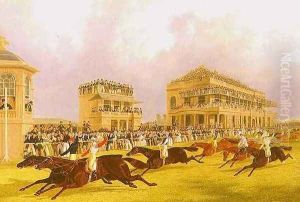J. F. & Pollard, James Herring Snr. Paintings
James Pollard was an English painter born in 1792 in Islington, London, into a world where the horse-drawn carriage was the primary mode of transportation. His father, Robert Pollard (1755–1838), was an engraver and publisher, which gave James early exposure to the art world. James Pollard's specialty was in coaching and sporting scenes, capturing the vibrant life of early 19th-century England with a keen eye for detail and movement. His works are notable for their dynamic compositions and meticulous depiction of horses and carriages, reflecting the era's fascination with speed and travel.
Pollard's career began in earnest when he started working for his father, creating engravings of his own paintings. He quickly established himself as a talented artist in his own right, moving beyond the shadow of his father's reputation. Throughout the 1820s and 1830s, Pollard produced a significant number of paintings and prints that depicted mail and stage coaches, horse races, and other scenes of public life. These works were highly popular, appealing to an audience that was fascinated by the rapidly changing landscapes of transportation and urbanization in Britain.
Despite the initial success, Pollard's life was not without its challenges. The advent of the railway in the 1840s led to a decline in the popularity of coaching scenes, impacting Pollard's commissions and financial stability. However, he adapted by shifting his focus to other subjects, including maritime and river scenes, though these never achieved the same level of acclaim as his coaching paintings.
James Pollard died in 1867, leaving behind a legacy that captured an important era in British history. His works are now valued not only for their artistic merit but also for their historical significance, offering a window into the age of horse-drawn transportation before the dominance of the steam engine. Pollard's paintings and prints remain sought after by collectors and are preserved in many art museums and private collections around the world.
